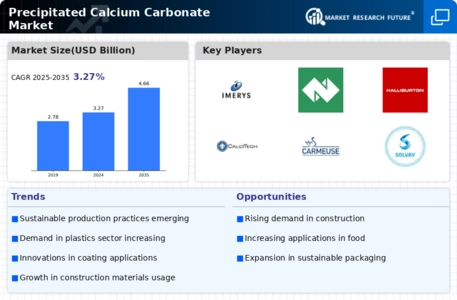Growth in the Paper Industry
The Precipitated Calcium Carbonate Market is significantly influenced by the paper manufacturing sector, which utilizes this compound as a filler and coating agent. The demand for high-quality paper products, particularly in packaging and printing, is on the rise. In 2025, the paper industry is expected to witness a growth rate of approximately 3.5%, which directly correlates with the increased consumption of precipitated calcium carbonate. This material enhances the brightness, smoothness, and printability of paper, making it a preferred choice among manufacturers. Furthermore, the shift towards eco-friendly paper production processes is likely to bolster the market, as precipitated calcium carbonate is a non-toxic and sustainable alternative to traditional fillers.
Expansion of the Plastics Sector
The Precipitated Calcium Carbonate Market is poised for growth due to the expanding plastics sector, where this compound is utilized as a filler to improve mechanical properties and reduce production costs. In 2025, the plastics industry is projected to grow at a rate of 4%, driven by increasing applications in automotive, consumer goods, and packaging. Precipitated calcium carbonate enhances the rigidity and impact resistance of plastic products, making them more durable. Additionally, the trend towards lightweight materials in various applications is likely to further increase the demand for precipitated calcium carbonate, as it provides an effective solution for manufacturers seeking to optimize their product performance while minimizing weight.
Rising Demand in Paint and Coatings
The Precipitated Calcium Carbonate Market experiences a notable surge in demand from the paint and coatings sector. This is primarily due to the material's ability to enhance the opacity and brightness of paints, which is increasingly sought after by manufacturers. In 2025, the paint and coatings segment is projected to account for a substantial share of the market, driven by the growing construction and automotive industries. The incorporation of precipitated calcium carbonate not only improves the aesthetic qualities of coatings but also contributes to cost efficiency, as it serves as a functional filler. As environmental regulations tighten, manufacturers are also leaning towards sustainable materials, further propelling the demand for precipitated calcium carbonate in this sector.
Technological Innovations in Production
The Precipitated Calcium Carbonate Market is benefiting from ongoing technological innovations in production processes. Advances in manufacturing techniques are leading to higher purity levels and improved particle size distribution, which are critical for various applications. In 2025, the market is likely to see an increase in the adoption of state-of-the-art production technologies that enhance efficiency and reduce environmental impact. These innovations not only improve the quality of precipitated calcium carbonate but also lower production costs, making it more competitive in various industries. As manufacturers strive to meet the growing demand for high-performance materials, the emphasis on technological advancements is expected to play a pivotal role in shaping the future of the market.
Increasing Use in Food and Pharmaceuticals
The Precipitated Calcium Carbonate Market is witnessing a growing application in the food and pharmaceutical sectors, where it serves as an additive and anti-caking agent. The demand for high-quality food products and pharmaceuticals is on the rise, with consumers increasingly seeking products that meet stringent safety and quality standards. In 2025, the food and pharmaceutical industries are expected to contribute significantly to the market, as precipitated calcium carbonate is recognized for its safety and efficacy. Its role in enhancing the texture and stability of food products, as well as its use in tablet formulations, positions it as a vital ingredient in these sectors. This trend indicates a potential for sustained growth in the market as regulatory frameworks evolve.

















Leave a Comment